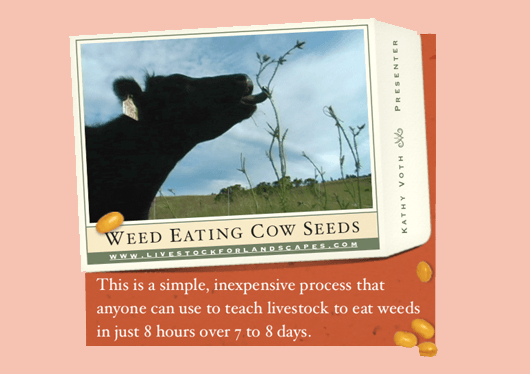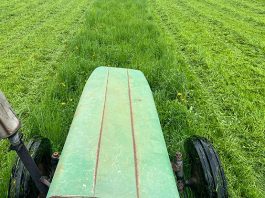This works for any animal – so whatever you’re raising, check it out!
 In 2004, I taught a small group of heifers to eat Canada thistle, leafy spurge and spotted knapweed. I was inspired by two decades of research on how animals choose what to eat, and by ranchers’ (perfectly reasonable) refusal to incorporate goats into their cattle operations. My thought was, “If everything in the research is true, then I should be able to teach a cow to eat a weed. And that would be MUCH easier than getting a rancher to buy goats.”
In 2004, I taught a small group of heifers to eat Canada thistle, leafy spurge and spotted knapweed. I was inspired by two decades of research on how animals choose what to eat, and by ranchers’ (perfectly reasonable) refusal to incorporate goats into their cattle operations. My thought was, “If everything in the research is true, then I should be able to teach a cow to eat a weed. And that would be MUCH easier than getting a rancher to buy goats.”
As it turns out, teaching a cow to eat a weed is very easy. It takes just eight hours spread over seven days. Educated cows add other pasture weeds to their diets on their own and they teach their offspring and herd mates. The don’t forget their new weeds over the winter, or ever, so you only have to train one group of animals once, and you’re done. Best of all, with an educated, weed-eating herd you have about 43% more forage.
Here’s how it works:
1. Know Your Weed
When I started teaching cows to eat weeds, I was drawing on two decades of research showing that animals choose what to eat based on a combination of the nutrients and toxins in the plant, and the animal’s own changing nutritional needs. The more nutritious the food is, the more likely an animal is to eat it. The lower in nutrients, the less the animal will eat. Toxins in plants reduce the amount an animal will eat of a plant. The higher the dose, the less it will eat. So, before I start training, I need to know if my pasture weed is nutritious and whether or not is has toxins that could cause health issues.
What I’ve learned in my sixteen years of working on this is that weeds that are green and growing are very nutritious. They have more leaf and less stem than grasses, so they have more Total Digestible Nutrients (TDN), and they are generally higher in protein than grasses, making them an excellent forage for grazers. (Here are some examples of weeds that are equal to or better than alfalfa.) I’ve also found that very few have dangerous toxins. If a weed has dangerous toxins, I do not train animals to eat it.
For a list of edible weeds check out the Cows Eat Weeds ebook set.
2. Choose Your Trainees
What I’ve learned from training over 1,000 cattle, a flock of sheep, some of Ted Turner’s bison, and my own goat herd is that any animal can learn. I started with yearling heifers because, as we all know, young animals are more likely to try new things. But when a rancher didn’t have heifers, I learned that cow calf pairs worked just as well. Old cows were no slower, bulls learned quickly, and all the sheep, bison and goats learned to eat new weeds.
The key to all of this is that it should be easy for YOU. Choose healthy animals that will be on your place for awhile, and that are in a pasture that is convenient. We’ll be using our animals’ competitive nature as part of the training, so it’s helpful to work with a group of at least 10 or more. I generally train groups of 25 to 50 at a time.
3. Make the Unfamiliar Seem Familiar

Routine makes everything seem normal. Your training routine will be to show up at a particular time, morning and afternoon, making the same sounds, driving the same vehicle, with the same feed tub/ trough, and something tasty for your trainees to try.
Every morning and afternoon for 4 days, you’ll feed an unfamiliar nutritious food. Just go to the feed store and pick 8 different things, one fifty pound bag per 25 cattle. Choose a variety of textures, flavors, shapes and smells (Soy flake, wheat bran, rolled oats, alfalfa pellets, range cubes, and COB for example). Trainees learn that every time you show up, they may not recognize what you’re giving them, but it will surely be something good to eat.
On the 5th, 6th, and 7th days skip the morning feeding. Then clip weeds, mix with a bit of feed and serve them up in the afternoon. You don’t need a lot of weeds for the training. Just loosely fill two 50 lb grain sacks or one 250 lb supplement tub per 25 cattle trainees. Weeds will just be one more new thing in a series of strange things. Trainees will try the weeds, get the good feedback, and begin eating them in pasture.
How can you tell if your trainees are eating weeds? At first they’re just learning how to get this strange new food in their mouths and they may not be too successful. If that’s the case, you’ll see lots of bent and broken stems, or you might find whole plants pulled up by the roots. You can also look for bitten off stems. Or, do what I do: Head out to the pasture in the evening when animals are getting up to graze and sit down in a patch of weeds. Your trainees will come over to check you out and when you do nothing, they’ll get bored and start looking around for things to eat. Since they’re in the weeds, they’ll eat them. This is how I’ve gotten lots of great video of cows eating weeds.
Here’s what it looks like in action. This is a herd of yearling heifers in Boulder County, Colorado. (You’ll notice that the training site doesn’t have a lot of great forage. That’s because this was a former coal mine tailings site. It was the only road accessible point on this 500 acre pasture so that’s where I needed to train.)
Want More?
Here’s a link to the books and resources I have that can help you get started. You’ll find:
 • The ebook set – Cows Eat Weeds, with the process, what I learned along the way and how I solved problems I encountered; and Edible Weeds & Training Links, a list of over 120 weeds and whether they’re safe to graze and a quick start recipe to get you going at home.
• The ebook set – Cows Eat Weeds, with the process, what I learned along the way and how I solved problems I encountered; and Edible Weeds & Training Links, a list of over 120 weeds and whether they’re safe to graze and a quick start recipe to get you going at home.
• Links to On Pasture articles about training, and different weeds animals have learned to eat, and
• Links to my Youtube channel with videos showing the training in action.
Enjoy!





This is great, practical use of research. In the video, when you are building fence, what are you wearing on your back to carry fence posts?
It’s a golf bag. Some folks I worked with in California introduced me to the idea. It was a great way to carry fence posts around. And instead of using the outside pocket for golf balls, I used it to carry extra fencing parts and my fence tester. I worked in an area where I wasn’t allowed to use a vehicle, so all I had was my legs and a pack. I preferred the golf bag to the backpack I used when I was building a mile of fence.
Comments are closed.